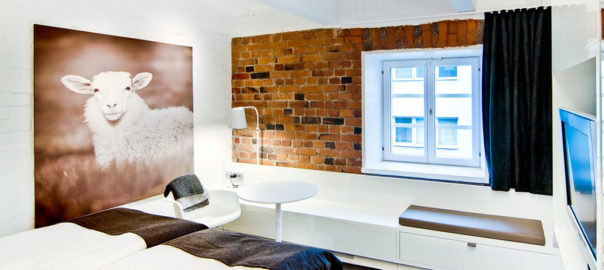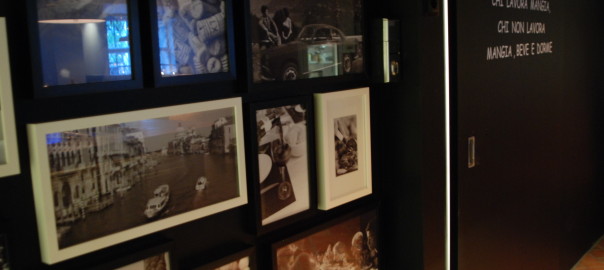After the renovation, Sokos Hotel Villa transformed into a hip city hotel. It has been open since July 2011, located centrally near the Tampere railway station and university campus.
Sokos Hotel Villa was once an old granary build in 1890 that added its charm as well as challenges to the design by featuring existing exposed brick walls, ceilings and columns. Due to the exposed ceiling, hotel room lighting was implemented by wall and floor lighting only i.e. bespoke wall lights by GI and concealed floor strip lights fitted within the joinery furniture. Cooling systems were also added to each hotel room, as well as all bathrooms and electricity were replaced.
The renovated rooms have a harmonious and warm atmosphere. Sustainable products were selected throughout such as the use of natural materials. One of the main themes of the renovation was sustainability and its outcome awarded Sokos Hotel Villa the Nordic Ecolabel, also known as the Swan. It is the official sustainibilty ecolabel in the Nordic countries.
The Memphis restaurants are popular meeting points among young people. The restaurant on Helsinginkatu (Hesari) was renewed according to a fresh new restaurant concept originally implemented at the Memphis Kamppi restaurant.
The project began when it was decided that the old kitchen of the summer restaurant Tammerin puisto would become a restaurant open for business throughout the year. The new Trattoria has a wine cellar feel to it and is a relaxed place to have a nice dinner.
The hotel was closed for renovation for nine months and now the 208 rooms, hallways, reception area, the Italian restaurant Ranta and conference rooms have new and improved interiors.
We were asked to create a cozy and elegant environment that would please the high quality demanding and international travelers. The rooms are now more spacious; the big desks were replaced with movable worktops. The surrounding nature was brought inside with photographic wallpapers which can be found in all of the rooms and in the reception. The reception area was designed so that it also accommodates the business travelers as a working area.
The F8 restaurant is located right in the heart of Helsinki on the 8th floor of Stockmann, the largest department store in the Nordic countries.
This is the flagship restaurant of Fazer Ltd, the largest food service company in the Nordic and Baltic countries, and also the biggest restaurant complex in Helsinki. The F8 houses a total of 8 restaurants, bars and cafes, including the luxurious champagne bar “Sweet”. Once all the sections are completed, the restaurant complex will have more than 800 seats.
Our job was to design the visual image for the restaurants and we were also responsible for the architectural and interior design. The first stage of the project was completed in spring 2009 with the second and final stage is scheduled for completion in spring 2010.
The Memphis restaurants are popular meeting points among young people. The starting point for the design project was that the restaurant chain’s visual image needed a fresher and more current look. The Kamppi restaurant was chosen as a pilot for the new look. The restaurant was completely renovated and refurbished. With the new interior design it was possibly to add more seats and supply more services both which have affected sales positively.
The story of Hotel Helka is intriguing. The building was commissioned by the YWCA in the turn of the century as a first home for young women relocating to Helsinki.
Over the years, lease residency turned into hotel services and today Helka is a well known accommodation option in the minds of both domestic and international tourists.
After years of intensive use the hotel and its restaurants were in need of a complete renovation and a new visual identity. The vision was to design a stylish and relaxed Finnish Helka. The interior design solutions emphasized domestic materials and products. The result was an interesting and streamlined design hotel.
The starting point of the project was that the old staff cafeteria needed more customer seats due to increase in staff. Also the food service area needed more space.
The area of the restaurant remained the same. After the project we were able to more customer seats and double the amount of cashier desks. The cafeteria is now more like a restaurant, a warm and comfortable meeting point.
The restaurant was completely refurbished and has 278 customer seats.
The restaurant is located in the very centre of Helsinki, on the corner of Kauppatori Market. It is part of the Palace Kämp chain of restaurants. Our design objective was to create a stylish look that would feel close to nature and preserve some of the feel of the local islanders, thus attracting customers who appreciate high-quality seafood.











